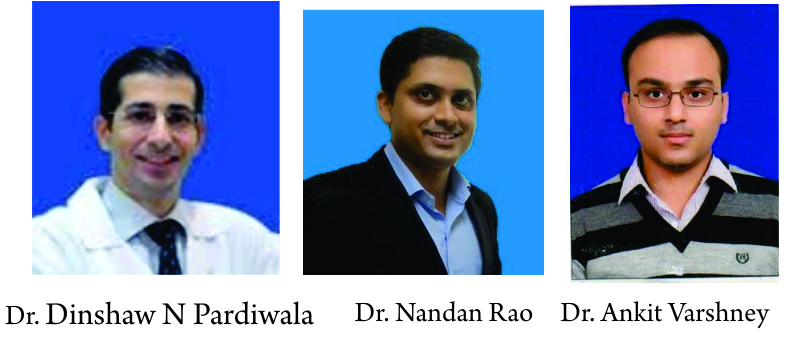Arthroscopic Repair for Massive Bony Bankart Lesions
Dinshaw N Pardiwala, Nandan Rao, Ankit Varshney
Volume 2 | Issue 1 | Jan – Apr 2017 | Page 15-19.
Author: Dinshaw N Pardiwala [1], Nandan Rao [1], Ankit Varshney [1]
[1] Arthroscopy & Shoulder Service Kokilaben Dhirubhai Ambani Hospital, Mumbai, India.
Address of Correspondence
Dr. Dinshaw Pardiwala
Head – Centre for Sports Medicine
Director – Arthroscopy & Shoulder Service, Kokilaben Dhirubhai Ambani Hospital
Mumbai, India.
Email: Dinshaw.Pardiwala@relianceada.com.
Abstract
A bony Bankart lesion is defined as a labro-ligamentous detachment of the glenoid rim along with a fragment of attached bone and is commonly associated with shoulder instability. When the fragment of bone extends over one quadrant of the glenoid, we have termed it as a “massive” bony Bankart lesion. Traditionally considered as a type of glenoid fracture, it is important to appreciate that these fractures are not isolated bony injuries. The bone fragments are always attached to the labrum and are avulsed along with the glenohumeral ligaments. Although these injuries have traditionally been treated with open reduction and fracture fixation techniques, in recent years, surgical repair for these lesions has shifted towards arthroscopic instability repair techniques. Although the choice of technique to fix bony Bankart lesions (single row suture anchor repair, suture bridge dual-row anchor repair, arthroscopic screw fixation) is surgeon-specific, this is often determined by a number of factors, including bone fragment size and quality, and the ease with which the fragment can be manipulated and viewed for reduction and fixation. There is no clinical data currently that proves the superiority of any technique, and all report a high rate of radiographic incorporation and clinical success. This paper describes the detailed technique for arthroscopic single row suture anchor massive bony Bankart repair.
Keywords: Bony Bankart Lesion, Arthroscopic Repair, surgical techniques.
References
1. Porcellini G, Paladini P, Campi F, et al. Long-term outcome of acute versus chronic bony bankart lesions managed arthroscopically. AJSM 2007;35(12):2067-2072.
2. Bigliani LU, Newton PM, Steinmann SP, Connor PM, McIlveen SJ. Glenoid rim lesions associated with recurrent anterior dislocation of the shoulder. AJSM 1998;26(1):41-45.
3. Griffith JF. et al. Prevalence, pattern, and spectrum of glenoid bone loss in anterior shoulder dislocation: CT analysis of 218 patients. American Journal of Radiology 2008;190:1247-1254.
4. Edwards TB, Boulahia A, Walch G. Radiographic analaysis of bone defects in chronic anterior shoulder instability. Arthroscopy 2003;19:732-739.
5. Burkhart SS, DeBeer JF. Traumatic glenohumeral bone defects and their relationship to failure of arthroscopic bankart repairs: Significance of inverted pear glenoid and the humeral engaging Hill Sachs lesion. Arthroscopy 2000; 16: 677-694.
6. Boileau P, Villalba M, Hery JY, Balg F, Ahrens P, Newyton L. Risk factors for recurrence of shoulder instability after arthroscopic Bankart repair. JBJS 2006; 88(8):1755-1763.
7. Tauber M, Resch H, Forstner R, Raffl M, Schauer J. Reason for failure after surgical repair of anterior shoulder instability. JSES 2004; 13(3); 279-285.
8. Sugaya H, Moriishi J, Dohi M, Kon Y, Tsuchiya A. Gleoind rim morphology in recurrent anterior glenohumeral instability. JBJS 2003; 85-A5; 878-884.
9. Burkhart SS, Danaceau SM. Articular arc length mismatch as a cause of failed Bankart repair. Arthroscopyc 2000;16:740-744.
10. Itoi E, Lee SB, Berglund LJ, Berge LL, An KN. The effect of a glenoid defect on anterioinferior stability of the shoulder after Bankart repair: A cadaveric study: JBJSA 2000;82(1) :35-46.
11. Ideberg R, Grevsten S, Larsson S. Epidemiology of scapular fractures. Incidence and classification of 338 fractures. Acta Orthop Scand. 1995;66(5):395-397.
12. Porcellini G, Campri F, Paladini P. Arthroscopic approach to acute bony Bankart lesion. Arthroscopy 2002 18(7);764-769.
13. Sugaya H, Moriishi J, Kanisawa I, Tsuchiya A. Arthroscopic osseous Bankart repair for chronic recurrent traumatic anterior glenohumeral instability. JBJS A 2005;87:1752-1760.
14. Mologne TS, Provencher MT, Menzel KA, Vachon TA, Dewing CB. Arthroscopic stabilization in patients with an inverted pear glenoid. AJSM 2007; 35(8): 1276-1283.
15. Kim YK, Cho SH, Son WS, Moon SH. Arthroscopic Repair of small and medium sized bony Bankart lesions. AJSM 2014;42:86.
16. Zhang J, Jiang C. A new “double pulley” dual row technique for arthroscopic fixation of bony Bankart lesion. Knee Surg Sports Traumatol Arthrosc 2011;19(9):1558-1562.
17. Millett PJ, Horan MP, Martstschlager F. The “bony Bankart bridge” technique for restoration of anterior shoulder instability. AJSM 2013; 41:608-614.
18. Giles JW, Puskas GJ, Welsh MF, Johnson JA, Athwal GS. Suture anchor fixation of bony Bankart fractures: Comparison of single-point with double-point “suture bridge” technique. AJSM 2013; 41:2624.
19. Cameron SE. Arthroscopic reduction and internal fixation of anterior glenoid fracture. Arthroscopy 1998; 14: 743-746.
20. Park JY, Lee SJ, Lhee SH, Lee, SH. Follow-up CT arthrographic evaluation of bony Bankart lesions after arthroscopic repair. Arthroscopy 2012;28(4):465-473.
21. Jiang CY et al. Do reduction and healing of the bony fragment really matter in arthrosopic bony Bankart Reconstruction? A prospective study with clinical and computed tomography evaluations. AJSM 2013;4:12617-2623.
| How to Cite this article:. Pardiwala DN. Rao N, Varshney A. Arthroscopic Repair for Massive Bony Bankart Lesions. Asian Journal of Arthroscopy Jan – April 2017;2(1):15-19. |




Leave a Reply
Want to join the discussion?Feel free to contribute!